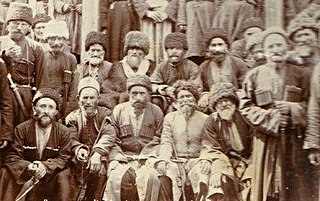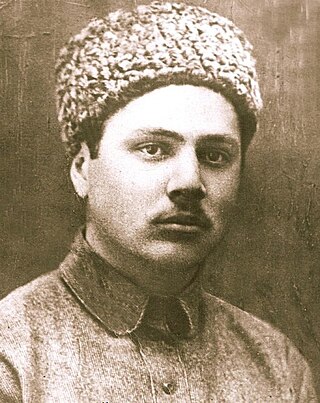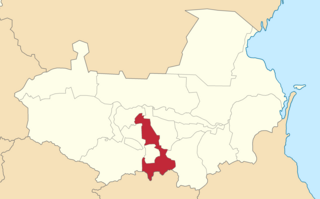Deportation of Chechens to Turkey
In 1860, Russia commenced with forced emigration to ethnically cleanse the region. Tsar Alexander II forced the exile of millions of Caucasians (including at least 100,000 Chechens) in 1860–1866. [1] [2] [3] Although Circassians were the main (and most notorious) victims (hence the "Circassian Genocide"), the expulsions also gravely affected other peoples in the region. It was estimated that 80% of the Ingush left Ingushetia for the Middle East in 1865. [4] [5] Lowland Chechens as well were evicted in large numbers, and while many came back, the former Chechen lowlands lacked their historical Chechen populations for a long period until Chechens were settled in the region during their return from their 1944–1957 deportation to Siberia. The Arshtins, at that time a (debatably) separate people, were completely wiped out as a distinct group: according to official documents, 1,366 Arshtin families disappeared (i.e. either fled or were killed), and only 75 families remained. [6] These 75 families, realizing the impossibility of existing as a nation of only hundreds of people, joined (or rejoined) the Chechen nation as the Erstkhoi tukkhum. [6] [7]
As Dunlop points out, the 100,000 Chechens who were exiled in 1860–1864 may have comprised over half the nation at that time, as in the 1896 Russian census, there were only 226,171 Chechens listed. [1]
Attempts to return
Some Chechens tried to return, but the Tsarist government refused to let them, even when they promised to convert to the Orthodox faith if they did. [8] [9] Nonetheless, some managed to return regardless.
Social trends
Conversion to Qadiri Islam
In the mid-1800s, the Qadiri sect of Sufism gained large numbers of followers among the Chechens (largely at the expense of the Nakshbandi sect). Eventually, an overwhelming majority of Chechens were Qadiri, separating them from their eastern neighbors in Dagestan who continued to follow the Nakshbandi sect. The zikr , which later came to be seen as more of a "Chechen custom" than a "Muslim or Qadiri custom", is the circular dance accompanied with chanting or singing, and was largely specific to the Qadiri sect (although later it became more ethnic as non-Qadiris joined in). Finally, the Qadiri sect focused much more on individual salvation rather than the need to improve society (as the Nakshbandi did). For this reason, the Russian government initially viewed this mass transition with the hope that its allegedly less societal mindset would mean an end to Chechen resistance to their rule. [10] However, in protest of unfavorable conditions, the Chechens rose up again in 1877–8, and the Qadiris played a major role in organizing the movement.
Land confiscation from the natives
In 1864, trying to dissuade further resistance, Tsar Alexander II issued a decree regarding the Caucasians' "religion, adat [Caucasian local law customs], lands and woods" stating that they would be preserved and protected "in perpetuity for the peoples of the North Caucasus". [9] However, it did not take Alexander long to break this promise. The Russian government seized large swathes (hundreds of thousands of hectares) of the best farming land and the best wooded land, and gave them to Cossacks. Considerable land was also awarded to Russian soldiers who would later assimilate with the surrounding Cossacks, identifying themselves as Cossacks. [9] These confiscations impoverished generations of Chechens and made large numbers of them land-hungry, sparking escalation of conflicts between Chechens and Cossacks. [9] [11] Chechen and Ingush clans in the area previously were forced to go without their traditional lands, and they maintained claims on the land throughout the whole period, jumping to reclaim the land as Russia receded in 1917.
Ethnic Discrimination
Ethnic discrimination occurred in many forms against Chechens during the Tsarist era of Chechen history, largely due to the colonialist viewpoint of the Russian government, viewing Chechens as inferior, savage and subversive, one of many peoples who Russia had a "moral duty to civilize". [12]
Judicial
During the Tsarist period, Cossacks and Russians were tried for all crimes in civilian courts, usually being taken into custody by civil authorities. By contrast, Chechens and Ingush (as well as some other ethnic groups in the region) were dealt with exclusively by the military and tried in military courts, where they were typically given drastically harsher sentences, often death for crimes such as stealing food. [9]
Land ownership
In addition to the initial land seizures, long term Russian policies favored the acquisition of more and more land by Russians at the expense of Chechens. In 1912, in their own homeland (and not including the lands north of the Terek that are often considered part of Chechnya and are currently within its jurisdiction), Chechens and Ingush owned well less than half as much land as Terek Cossacks did, per capita. Chechens had 5.8 desyatinas [13] on average, Ingush had 3.0, and Terek Cossacks had 13.6. [14]
Socioeconomic and Demographic changes
By the end of the 19th century, major oil deposits were discovered around Grozny (1893) which along with the arrival of the railroad (early 1890s), brought economic prosperity to the region (then administered as part of the Terek Oblast) for the oil-mining Russian colonists. The immigration of colonists from Russia brought about a three-way distinction between Chechens and Ingush on one hand, Cossacks on a second, and "other-towners" (inogorodtsy), namely Russians and Ukrainians, who came to work as laborers. [15] A debatable fourth group, including Armenian bankers and richer Russians, and even some rich Chechens (such as Tchermoeff), arose later. Some Chechens got rich off oil, and the industry brought wealth to Chechnya, and (along with other factors) caused a growth of a Chechen bourgeoisie and intelligentsia.
Emergence of nationalism
During the late 1860s and 1870s, a modest Chechen national awakening in literary circles occurred. The conflict with Russia and its final incorporation into the empire, however, brought about the formation of a modern, European, nationalist identity of some Chechen writers, though it ironically solidified their separation, mainly over politics, from the Ingush. [16] The nation was held to be all-important, trumping religion, political belief, or any other such distinction. [17] In 1872, Umalat Laudaev, an early Chechen nationalist, recorded the contemporary customs of the Chechens.
Other notable early Chechen nationalists included Akhmetkhan, Ibraghim Sarakayev, and Ismail Mutushev. Later Tsarist-era Chechen nationalists include the five Sheripov brothers, among others. Among these, Sarakayev, Mutushev, Akhmetkhan and Danilbek Sheripov were notably democratic-minded writers, while Danilbek's younger brother, Aslanbek, would adopt communism. [18]

Chechnya, officially the Chechen Republic, is a republic of Russia. It is situated in the North Caucasus of Eastern Europe, between the Caspian Sea and Black Sea. The republic forms a part of the North Caucasian Federal District, and shares land borders with the country of Georgia to its south; with the Russian republics of Dagestan, Ingushetia, and North Ossetia-Alania to its east, north, and west; and with Stavropol Krai to its northwest.

Grozny is the capital city of Chechnya, Russia.

A teip is a Chechen and Ingush tribal organization or clan, self-identified through descent from a common ancestor or geographic location. It is a sub-unit of the tukkhum and shahar. There are about 150 Chechen and 120 Ingush teips. Teips played an important role in the socioeconomic life of the Chechen and Ingush peoples before and during the Middle Ages, and continue to be an important cultural part to this day.
The history of Chechnya may refer to the history of the Chechens, of their land Chechnya, or of the land of Ichkeria.

The Chechens, historically also known as Kisti and Durdzuks, are a Northeast Caucasian ethnic group of the Nakh peoples native to the North Caucasus. They are the largest ethnic group in the region and refer to themselves as Nokhchiy. The vast majority of Chechens are Muslims and live in Chechnya, an autonomous republic within the Russian Federation.

Ingushetia or Ingushetiya, officially the Republic of Ingushetia, is a republic of Russia located in the North Caucasus of Eastern Europe. The republic is part of the North Caucasian Federal District, and shares land borders with the country of Georgia to its south; and borders the Russian republics of North Ossetia–Alania to its west and north and Chechnya to its east and northeast.

The Terek Cossack Host was a Cossack host created in 1577 from free Cossacks who resettled from the Volga to the Terek River. The local aboriginal Terek Cossacks joined this Cossack host later. In 1792 it was included in the Caucasus Line Cossack Host and separated from it again in 1860, with the capital of Vladikavkaz. In 1916 the population of the Host was 255,000 within an area of 1.9 million desyatinas.

The peoples of the Caucasus, or Caucasians, are a diverse group comprising more than 50 ethnic groups throughout the Caucasus.

The Nakh peoples are a group of North Caucasian peoples identified by their use of the Nakh languages and other cultural similarities. These are chiefly the ethnic Chechen, Ingush and Bats peoples of the North Caucasus, including closely related minor or historical groups.

Abrek is a North Caucasian term used for a lone North Caucasian warrior living a partisan lifestyle outside power and law and fighting for a just cause. Abreks were irregular soldiers who abandoned all material life, including their family and friends, in order to fight for a just cause, to worship, and to meditate. The term was mostly used by people who struggled against Russian colonialism, mostly a guerrilla struggle during Russian expansion in the North Caucasus in the 19th century. An abrek would renounce any contact with friends and relatives, and then dedicate his life to praying and fighting for justice. Some abreks stole from the rich to give to the poor while others protected Caucasian villages from foreign attacks. The abrek lifestyle included a lonely life in the unexplored wilderness. Later, the majority of abreks became devoted Sufi Muslims. During the Caucasian War, which is divided into the Russo-Circassian War and the Murid War, there was constant raids between Russian and Caucasian settlements.
The 1940–1944 insurgency in Chechnya was an autonomous revolt against the Soviet authorities in the Chechen-Ingush Autonomous Soviet Socialist Republic. Beginning in early 1940 under Hasan Israilov, it peaked in 1942 during the German invasion of North Caucasus and ended in the beginning of 1944 with the wholesale concentration and deportation of the Vainakh peoples from their native lands as well as from the locations across the USSR, resulting in the death of at least 144,000 civilians. However, scattered resistance in the mountains continued for years.
Umar Dimayev was a Chechen accordionist and folk musician. His sons, Ali, Valid, and Said are also professional Chechen musicians.

The deportation of the Chechens and Ingush, or Ardakhar Genocide, and also known as Operation Lentil, was the Soviet forced transfer of the whole of the Vainakh populations of the North Caucasus to Central Asia on 23 February 1944, during World War II. The expulsion was ordered by NKVD chief Lavrentiy Beria after approval by Soviet leader Joseph Stalin, as a part of a Soviet forced settlement program and population transfer that affected several million members of ethnic minorities in the Soviet Union between the 1930s and the 1950s.
The Vainakh peoples of the North Caucasus were Islamised comparatively late, during the early modern period, and Amjad Jaimoukha (2005) proposes to reconstruct some of the elements of their pre-Islamic religion and mythology, including traces of ancestor worship and funerary cults. The Nakh peoples, like many other peoples of the North Caucasus such as Circassians, practised tree worship, and believed that trees were the abodes of spirits. Vainakh peoples developed many rituals to serve particular kinds of trees. The pear tree held a special place in the faith of Vainakhs.

Mairbek Sheripov was one of the leaders of Chechen insurgency against the Soviet Union in the 1940s. Mairbek Sheripov was a younger brother of Aslanbek Sheripov, a Bolshevik revolutionary killed in a battle with the Denikinites in 1919. A jurist by profession, he worked for the Soviet government in the Chechen-Ingush ASSR. In 1941, he joined a Chechen insurrection led by Khasan Israilov. He was killed on 7 November 1942 in a Soviet reprisal raid.
Balkar and Karachay nationalism is the national sentiment among the Balkars and Karachai. It generally manifests itself in:
During the 13th and 14th centuries, the Mongols launched two long, massive invasions of the territory of modern Chechnya and Ingushetia, which included the lands of Alania in the west, Simsir in the northeast, and the Georgian-allied polity of Durdzuketia in the south. They caused massive destruction and human death for the Durdzuks, but also greatly shaped the people they became afterward. However, this came at great cost to them, and the states they had built were utterly destroyed, as were their previous organized systems. These invasions are among the most significant occurrences in Chechen and Ingush history, and have had long-ranging effects on Chechnya, Ingushetia and their peoples.
The Chechen wolf, or gray wolf, is the national animal of the Chechen nation.

The Chechen–Russian conflict was the centuries-long ethnic and political conflict, often armed, between the Russian, Soviet and Imperial Russian governments and various Chechen forces. The recent phase of the conflict started after the dissolution of the Soviet Union in 1991 and ended with the oppression of Chechen separatist leaders and crushing of the separatist movement in 2017.

The Nazran okrug, known after March 1917 as the Ingush okrug, was a district (okrug) of the Terek Oblast of the Caucasus Viceroyalty of the Russian Empire, and after 1921, the Mountain ASSR of the Russian SFSR within the Soviet Union. The district was modest in its population of 59 thousand and size of approximately 1,500 square kilometres (580 sq mi), the smallest of all the Terek Oblast's subdivisions in both measures. The administrative centre of the district was the city of Vladikavkaz.













